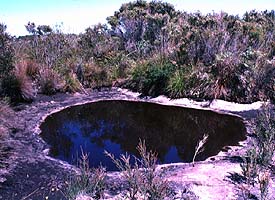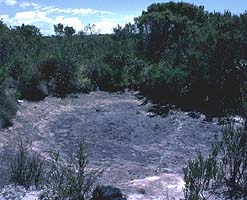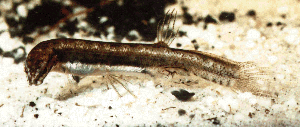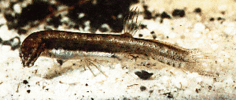Lepidogalaxiidae
Lepidogalaxias salamandroides
The Salamanderfish of Western Australia
Tim M. BerraIntroduction
The family Lepidogalaxiidae contains the single species Lepidogalaxias salamandroides, the salamanderfish, described by Mees (1961). The small (slightly more than 2 inches) and slender salamanderfish has a restricted distribution in south-west Western Australia on heathland peat flats between Blackwood and Kent rivers, a distance of 180 km centered on Northcliffe, W.A. (Allen and Berra 1989). This unusual species lives in dozens of heathland pools and streams in an area of winter rains and summer drought. About 120-150 fish may exist in these ephemeral, "black" waters that are acidic with pH 3.8-5.5 (Berra and Allen 1989). The pools are shallow (33-100 cm) and mostly small (2-600 sq. m.) with the largest nearly 2,200 sq. m.). Water temperature varies greatly in 24 hours from 16 °C to 34 °C in summer. Most pools evaporate by January and remain dry until late May, as shown in the illustration.



On the left, a Lepidogalaxias pool on 6 December 1988. Water level is dropping as summer advances. In November the pool was completely full with water at the edge of the vegetation. The same pool one month later on 5 January 1989. The pool has completely evaporated. Where are the fish? They are buried in the damp sand. Kangaroo footprints can be seen in the pool bottom.
Characteristics
The salamanderfish is a small, elongate fish. The dorsal and anal fins are posteriorly positioned and the dorsal fin is usually held erect. The fish often rests on its elongate pelvic fins and rounded caudal fin. Salamanderfish can bend their heads left and right and up and down.
The following is a more detailed description. Body elongate, slender, and scaled; head blunt; dorsal fin tall, short-based, with 5-7 fin rays, posterior to pelvics and above anal fin; no adipose fin; pelvic fins abdominal with 4 elongate rays; anal fin with 11-12 fin rays, that of males with modified rays and scaly sheath; caudal fin rounded or lanceolate and with 12-14 fin rays; pectoral fin with 10-12 rays. Maximum standard length 67 mm. Olive with black blotches, belly silvery-white,fin membranes colorless. Blotches on males form dark mid-lateral stripe extending through eye.
Natural history
Salamanderfish survive desiccation of their habitat by burrowing into bottom sand where they are moistened by ground water. They have been recovered from 2-60 cm deep in sand (Berra and Allen 1989). During this time they exchange gases through their skin (Martin et al. 1993) and metabolize fat reserves (Pusey 1990). Urea is stored during estivation and excreted upon arousal (Pusey 1986). Salamanderfish have no accessory respiratory structures (Berra et al. 1989), and no special ability to tolerate hypoxic water (Berra and Allen 1995). They reemmerge immediately following summer rain and burrow back into sand as temporary pools evaporate. Salamanderfish reemerged within 10 minutes of releasing 2,700 liters of water from fire truck into dry pools (Berra and Allen 1989). Only 3 of 29 fish survived induced estivation (Pusey 1989).
The wedge-shaped skull of Lepidogalaxias is robust and resists the weight of damp sand when buried. Large gaps between vertebrae and reduced abdominal ribs give body great flexibility (Berra and Allen 1989). This facilitates wiggling through damp sand. Eye muscles are absent (McDowall and Pusey 1983) and wide gap between skull and first vertebra allows neck-bending which may compensate for inability to rotate eyes (Berra and Allen 1989).
The diet of salamanderfish consists mainly of insect larvae (Allen and Berra 1989). About 32% of population are juveniles under 25 mm in length and 56% are adults 25-39 mm. The sex ratio about 1:1. Many fish live two years, but some females survive five years. Females reach greater size than males. The males' anal fin is sexually dimorphic at 25 mm. Rosen (1974) speculated that anal fin of the male may be used for sperm transmission. Leung (1988) suggested that internal fertilization was an adaptation to acidic environment. Pusey and Stewart (1989) observed salamanderfish mating and confirmed internal fertilization without courtship. Males join to females by a sticky mucus produced by a scaly sheath of the anal fin. Mature females have 100-400 eggs from 1.1-1.3 mm in diameter (Pusey 1990). Spawning takes place in winter (June-August) when water levels are highest. By October juveniles are large enough to be collected with a seine. Growth and development are rapid, and juveniles are ready to estivate by summer (Berra and Allen 1991).
Because of limited habitat any environmental destruction or pollution could affect populations of Lepidogalaxias. Wood chipping in mixed karri (Eucalyptus diversicolor) and jarrah (E. marginata) forests is a serious threat affecting their watershed. A conservation measure that would probably ensure survival of the species well into next century would be incorporation of the unique acid-flats environment around Northcliffe into a protected state or national sanctuary and elimination of forest destruction.
Phylogenetic Position of Lepidogalaxias
The phylogenetic affinity of this bizarre little fish has been enigmatic since Mees (1961) described it as a galaxiid. Rosen (1974) stated that Lepidogalaxias was most closely allied to Northern Hemisphere esocoids, but Fink and Weitzman (1982) disputed this assertion claiming that the characters used by Rosen were convergent and inappropriate. Fink (1984) referred to Lepidogalaxias as a "potpouri of contradictory and reductive characters" and placed it in an unresolved trichotomy with the Salmonidae as the sister group of the Neoteleostei. Williams (1987) considered Lepidogalaxias to be a member of the Southern Hemisphere assemblage of galaxioid fishes. Begle (1991) placed the Lepidogalaxiidae as an osmeroid family within the Southern Hemisphere Galaxioidea clade along with the Retropinnidae (including Prototroctes), Salangidae, and the Galaxiidae (including Aplochiton and Lovettia). Nelson (1994) followed Begle. Based on a study of intermuscular bones, Patterson and Johnson (1995) supported Begle's (1991) placement of Lepidogalaxias among galaxioid osmeroids as the sister group of salangids + galaxiids. Johnson and Patterson (1995) severely criticised Begle's work and stated that Lepidogalaxias and Lovettia are sister groups within the Galaxiidae. MtDNA studies in Axel Meyer's lab at Stony Brook N.Y, with the author, are in progress.
Other Names for Lepidogalaxias salamandroides
- salamanderfish
- Lepidogalaxiidae
- salamander fish
- The Salamanderfish of Western Australia
References
Allen, G. R. & T. M. Berra. 1989. Life history aspects of the West Australian salamanderfish, Lepidogalaxias salamandroides Mees. Rec. West. Aust. Mus. 14: 253-267.
Begle, D. P. 1991. Relationships of the osmeroid fishes and the use of reductive characters in phylogenetic analysis. Syst. Zool. 40: 33-53.
Berra, T. M. & G. R. Allen. 1989. Burrowing, emergence, behavior, and functional morphology of the Australian salamanderfish, Lepidogalaxias salamandroides. Fisheries 14(5): 2-10.
Berra, T. M. & G. R. Allen. 1991. Population structure and development of Lepidogalaxias salamandroides (Pisces: Salmoniformes) from Western Australia. Copeia 1991: 845- 850.
Berra, T. M. & G. R. Allen. 1995. Inability of salamanderfish, Lepidogalaxias salamandroides, to tolerate hypoxic water. Rec. West. Aust. Mus. 17: 117.
Berra, T. M., D. M. Sever, & G. R. Allen. 1989. Gross and histological morphology of the swimbladder and lack of accessory respiratory structures in Lepidogalaxias salamandroides, an aestivating fish from Western Australia. Copeia 1989: 850-856.
Christensen, P. 1982. The distribution of Lepidogalaxias salamandroides and other small fresh-water fishes in the lower south-west of Western Australia. J. Roy. Soc. West. Aust. 65: 131-141.
Fink, W. L. 1984. Basal euteleosts: relationships, p. 202-206 In Ontogeny and systematics of fishes. Special Publ. No. 1, American Society of Ichthyologists and Herpetologists.
Fink, W. L. and S. H. Weitzman. 1982. Relationships of the stomiiform fishes (Teleostei) with a description of Diplophos. Bull. Mus. Comp. Zool. 150: 31-93.
Johnson, D. G. and C. Patterson. 1995. Interrelationship of lower euteleostei. Abstract, 75th Annual Meeting of American Society of Ichthyologists and Herpetologists.
Leung, L. K-P. 1988. Ultrastructure of the spermatozoon of Lepidogalaxias salamandroides and its phylogenetic significance. Gamete Research 19: 41-49.
McDowall, R. M. & B. J. Pusey. 1983. Lepidogalaxias salamandroides Mees--a redescription, with natural history notes. Rec. West. Aust. Mus. 11: 11-23.
Martin, K. L. M., T. M. Berra, & G. R. Allen. 1993. Cutaneous aerial respiration during forced emergence in the Australian salamanderfish, Lepidogalaxias salamandroides. Copeia 1993: 875-879.
Mees, G. F. 1961. Description of a new fish of the family Galaxiidae from Western Australia. J. Roy. Soc. West. Aust. 44: 33-38.
Patterson, C. and G. D. Johnston. 1995. The intermuscular bones and ligaments of teleostean fishes. Smithsonian Contribution to Zoology No. 559.
Pollard, D. A., B. A. Ingram, J. H. Harris, & L. F. Reynolds. 1990. Threatened fishes in Australia--an overview. J. Fish Biol. 37: 67-78.
Pusey, B. J. 1986. The effect of starvation on oxygen consumption and nitrogen excretion in Lepidogalaxias salamandroides (Mees). J. Comp. Physiol. B 156: 701-705.
Pusey, B. J. 1989. Aestivation in the teleost fish Lepidogalaxias salamandroides (Mees). Comp. Biochem. Physiol. 92A: 137- 138.
Pusey, B. J. 1990. Seasonality, aestivation and the life history of the salamanderfish Lepidogalaxias salamandroides (Pisces: Lepidogalaxiidae). Env. Biol. Fish. 29: 15-26.
Pusey, B. J. & D. H. D. Edward. 1990. Structure of fish assemblages in waters of the southern acid peat flats, south-western Australia. Aust. J. Mar. Freshwater Res. 41: 721-734.
Pusey, B. J. & T. Stewart. 1989. Internal fertilization in Lepidogalaxias salamandroides Mees (Pisces: Lepidogalaxiidae). Zool. J. Linn. Soc. 97: 69-79.
Rosen, D. E. 1974. Phylogeny and zoogeography of salmoniform fishes and relationships of Lepidogalaxias salamandroides. Bull. Am. Mus. Nat. Hist. 153: 265-326.
Williams, R. R. G. 1987. The phylogenetic realtionships of the salmoniform fishes based on the suspensorium and its muscles. Unpubl. Ph.D. Dissertation, Zoology Dept., University of Alberta, Edmonton, Canada.
Title Illustrations

| Scientific Name | Lepidogalaxias salamandroides |
|---|---|
| Copyright |
© 1995 Tim M. Berra

|
About This Page
Tim M. Berra

Ohio State University, Mansfield, Ohio, USA
Page copyright © 1995 Tim M. Berra
All Rights Reserved.
Citing this page:
Berra, Tim M. 1995. Lepidogalaxiidae. Lepidogalaxias salamandroides. The Salamanderfish of Western Australia. Version 01 January 1995. http://tolweb.org/Lepidogalaxias_salamandroides/15164/1995.01.01 in The Tree of Life Web Project, http://tolweb.org/









 Go to quick links
Go to quick search
Go to navigation for this section of the ToL site
Go to detailed links for the ToL site
Go to quick links
Go to quick search
Go to navigation for this section of the ToL site
Go to detailed links for the ToL site